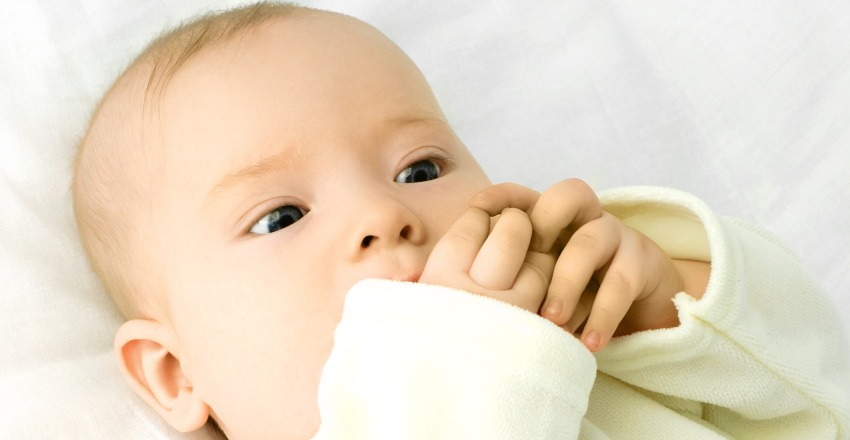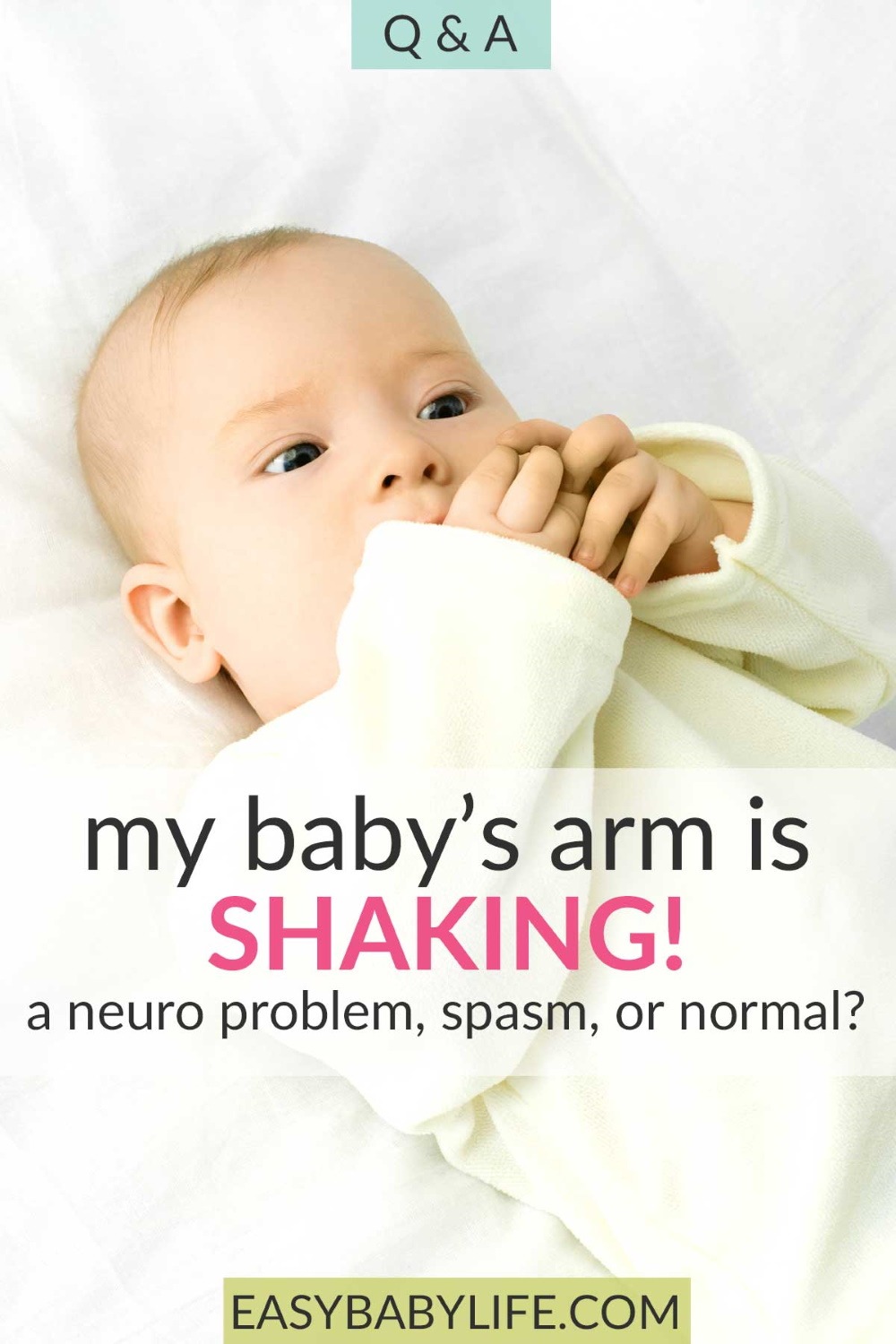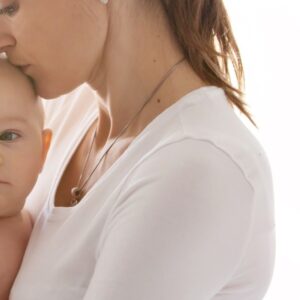If your baby’s arm is shaking or your child is trembling or shaking in other ways, this article will help you identify possible reasons – from a normal immature nervous system, newborn reflexes, and shuddering attacks to metabolic issues, illnesses, and seizures.
Also, learn the signs that you should contact a doctor.

The information in this article is provided by Pediatrician Leah Alexander. The purpose is to provide examples and knowledge to help parents dig deeper into their baby’s situation, not to offer a complete picture or a possible diagnosis. Medical concerns should always be handled by a doctor who meets the patient.
Dad’s Question:
Our 4 1/2-month-old baby’s arm is shaking! It starts to shake when he is attempting to grab something and can’t get his grip on it or when getting annoyed or sleepy and is about to cry. It appears that this begins mainly when these things are happening around him.
The shaking stops when we hold his hands, but when you let go, it picks right back up again. The best way to describe it would be as if someone was super excited or nervous that their arms would be shaking in that way.
We don’t know if this is just a part of growing up or something a bit more serious. These happen throughout the day, and then he holds his hands nice and straight at other times.
Is it any kind of neuro problem?? I would appreciate any input!
Thank you!
Isaac
Baby’s Arm is Shaking – Possible Reasons to Consider
Normal Shaking in Baby
1. Immature Nervous System
What you describe may be normal shaking due to your baby’s immature nervous system or other expected reasons.
I remember believing that my firstborn suffered from some kind of brain damage when she was a newborn due to her weird movements and shaking… But it turned out to be completely normal newborn movements.
Certain shaking movements are normal and expected during infancy. Such movements are typically brief and can be easily stopped by holding the affected body part. During the shaking episode, the baby otherwise seems normal and shows no signs of illness. Normal shaking movements self-resolve as the baby grows and the brain matures.
2. Newborn reflexes
The nervous system of full-term infants is immature at birth and even more so in premature infants. Reflex movements that are present during the first few months of life are replaced by new developmental skills as the baby grows.
Moro Reflex
This movement is a sudden, brief jerking of the arms and legs with the fingers fanning outward on the hands. The shaking stops when the arms or legs are held. It is typically seen when a baby is startled or something unexpected occurs. The baby may also cry. It is normal for this reflex to occur several times a day, including during sleep. In most babies, it resolves by the age of four months.
Tonic-Neck Reflex
Also called the “fencing reflex,” this movement occurs when a parent turns the baby’s head toward the shoulder. In response, the arm reflexively extends outward in the same direction as the head. Instead of a shaking motion, it is more of an arm stiffening. This reflex resolves between five to seven months old.
3. Crying movements
Infants may exhibit brief shaking movements in various body areas when they become upset. Lip quivering is common, both before or during a crying episode. Newborns may shake their arms and legs vigorously while crying, but this should resolve by age two months.
4. Shuddering Attacks
Shuddering attacks are brief but sudden, uncontrollable movements of the head and arms. The infant or toddler otherwise appears normal during the episodes, and there is no loss of consciousness. In many ways, however, the episodes resemble seizures.
Here is a video showing what such an attack may look like:
Because it is difficult for parents to distinguish this type of shaking from more concerning conditions, they should consult a doctor. Shuddering attacks require no treatment and self-resolve by ages two to three.
Abnormal Shaking in Babies
Other shaking movements in infants are a sign of a medical problem. They are often described as jitteriness or tremors: involuntary, rhythmic, and periodic movements. The shaking persists despite holding the affected area and may be associated with a change in behavior or consciousness.
In these situations, a doctor should evaluate the cause of the shaking and determine if treatment is necessary.
Metabolic problems
5. Hypoglycemia
Some infants experience low blood sugar during the first few days of life. While a modest decrease during the initial hours is normal, routine newborn care promotes stabilization of the blood sugar level. This includes immediately drying and warming the baby and initiating feedings.
Risk factors for persistent hypoglycemia are intrauterine growth retardation, low birth weight, maternal diabetes, and prematurity. In other cases, a complicated birth process can cause stress that depletes the infant’s glucose reserves. The persistence of low blood sugar usually indicates the presence of another medical problem.
The movement seen in infants with hypoglycemia can be described as jitteriness. Other signs include difficulty maintaining a normal body temperature, poor feeding, and irritability. In severe cases, seizures or coma can develop.
6. Vitamin D Deficiency
Vitamin D is important for a variety of normal body functions. It is essential for calcium absorption into bones and plays a role in immunity and preventing chronic diseases.
Low vitamin D levels have been documented in newborns who have tremors. It is believed that low transfer of vitamin D from the mother to the fetus contributes to this. Tremors resolve once vitamin D supplementation is initiated after birth.
In addition, breastmilk is naturally low in vitamin D. The World Health Organization and the American Academy of Pediatrics recommend vitamin D supplements for all breastfed infants. Infant formulas are fortified with vitamin D, so supplementation is unnecessary for formula-fed infants.
7. Magnesium Deficiency
Magnesium is an electrolyte that helps the skeletal muscles and heart contract properly and is important for various metabolic functions. Vitamin D, estrogen, and the kidneys help maintain normal magnesium levels in the blood.
Very low levels can cause infantile tremor syndrome, seen most often between the ages of six to 30 months.; Frequent shaking movements occur while the baby is awake but not during sleep. Magnesium supplementation not only improves this condition but prevents future associated developmental delays.
This condition is rare in situations where adequate nutrition is available.
Seizures
When parents witness any form of shaking, their first thought may be, “Is my baby having a seizure?”; Seizures are unusual body movements or behaviors that occur due to a specific trigger.
Many parents may recognize seizures involving the whole body stiffening or jerking, during which consciousness is lost.
Other types of seizures may affect only one area of the body or be associated with no movement at all; the baby is “awake” but unresponsive during the latter type. Many seizures are associated with abnormal brain wave activity that can be detected by an electroencephalogram (EEG).
Any infant who experiences such symptoms should be evaluated by a healthcare provider.
8. Febrile Seizures
In the presence of illnesses, rapid increases in body temperature can trigger a seizure in infants and toddlers. The whole body shakes or jerks, the eyes roll back, and consciousness is lost during these episodes. They are common between the ages of six months to three years old and may reoccur during subsequent febrile illnesses.
Unlike other seizure types, there is no short-term or long-term brain injury. Aside from fever management, no medications are necessary. Most children outgrow this tendency by age five.
9. Infantile Spasms
Infantile spasms develop between the ages of two to 12 months old. They are characterized by repetitive spasms which last only five to ten seconds. In many cases, the episodes are very subtle and difficult to recognize.
The most concerning aspect is the detrimental effect on infant development. Previously achieved motor, social, and cognitive milestones are lost. For example, a four-month-old who frequently coos and smiles will stop doing so. Because of the potential for poor outcomes, it is important for these babies to receive an evaluation by a pediatric neurologist as soon as such changes are detected.
10. Seizures Due to Other Medical Problems, including Infections
There are numerous medical conditions for which seizures are a primary symptom. Seizures are common in infants who experience birth trauma or are born with a brain malformation. One in 2500 infants is born with a genetic or metabolic disorder that can be associated with seizures.
A potentially preventable cause is infection; prompt medical intervention is critical to a good prognosis.
Meningitis is an inflammation of the protective sac surrounding the brain and spinal cord. Viruses, bacteria, fungi, and tuberculosis can all cause this condition. During the first three months of life, infants are at high risk of bacterial meningitis caused by group B Streptococcus, E. Coli, or Listeria monocytogenes.
These infections are most often transmitted perinatally from the mom but may not be evident for several weeks. Older infants are prone to developing pneumococcal and meningococcal infections.
Infants who develop bacterial meningitis usually become quite ill. Classic signs are a bulging “soft spot,” lethargy, or irritability. Those who survive develop seizures after recovery and other neurological deficits.
Encephalitis is defined as inflammation of the brain tissue itself. In infants, herpes viruses are the most common etiology. Similar to cases of meningitis, infants with encephalitis appear very ill and have diminished responsiveness and fevers. They may experience seizures during the acute phase of the illness and after recovery.
Other causes of shaking in babies
11. Benign Spasms of Infancy
This condition was previously known as non-epileptic infantile spasms or benign myoclonus because of the “jerking” nature of the movements. During the episodes, the head, neck, and upper body experience a one to two-minute spasm. Despite their appearance, benign spasms of infancy are not seizures.
The average age of onset is five months old, with resolution by age three.
12. Neonatal Abstinence Syndrome
Infants who have had prenatal exposure to opioids, alcohol, and other substances can develop jitteriness and tremors a few days after birth. Other symptoms include high-pitched crying, irritability, difficulty sleeping, and poor feeding. Hospital care is necessary to support infants through withdrawal.
Long-term neurological and cognitive effects can result depending on the amount and timing of exposure.
When to Call A Doctor
Shaking in an infant can be a scary and worrisome sight for parents. Although some types of shaking are normal, if there is any suspicion that something may be wrong, it is best to consult a doctor. Here are signs that indicate medical intervention is needed:
- Loss of consciousness
- Shaking continues despite holding the affected area
- Abnormal eye movements
- Change in behavior (lethargy, irritability, poor feeding)
- Regression of a developmental skill
Answer to the Question
Now, back to your question after this overview. Your baby’s arm is shaking, and based on the description, it would be best to have the baby evaluated by a pediatrician. At five months old, the Moro reflex should have resolved. While it is reassuring that the shaking stops while the baby’s hand is held, a doctor can determine whether or not the shaking is normal or a sign of concern.
I hope this helps,
Paula
P.S. Hey, parents! If your baby’s arm is shaking too, or you have experiences of similar situations, please share below!
Read Next: Babies With Shaking And Seizure Issues
- Baby Shaking Head – Why?
- Why are My Baby’s Eyebrows Twitching? (Facial Twitches in Kids)
- Baby Shakes After Waking Up
- Baby Started Shaking While Eating
Research References
- The Moro Reflex
- The Tonic Neck Reflex
- Newborn reflexes and behavior
- Shuddering attacks
- Neonatal Hypoglycemia
- Benign Neonatal Shudders, Shivers, Jitteriness, or Tremors: Early Signs of Vitamin D Deficiency
- Neonatal Seizure
- Febrile Seizures
- Infantile Spasms: Symptoms, Causes & Treatment
- Inborn Errors of Metabolism
- Neonatal Meningitis: Risk Factors, Causes, and Neurologic Complications
- Encephalitis in Previously Healthy Children
- Benign spasms of infancy: a mimicker of infantile epileptic disorders
- Neonatal Abstinence Syndrome

Paula Dennholt founded Easy Baby Life in 2006 and has been a passionate parenting and pregnancy writer since then. Her parenting approach and writing are based on studies in cognitive-behavioral models and therapy for children and her experience as a mother and stepmother. Life as a parent has convinced her of how crucial it is to put relationships before rules. She strongly believes in positive parenting and a science-based approach.
Paula cooperates with a team of pediatricians who assist in reviewing and writing articles.






My 3 months old baby shake her legs when she touch objects. We took her to the Dr; she did a blood test and ultrasound. It was all normal but I’m still worried. She is been doing it since from 2 weeks old.
Her Dr think it’s just a immature nervous system and she will get better.
My Baby is 28 days old and shaking happened today 8-10 times today in the left part of his body. Doctor said it could be due to lack of calcium in the body .
I am concerned what could be the reason.
Hi Sunny,
Will the Dr check calcium levels? I can’t say what the reason is. Newborn babies tend to do a lot of shaking and strange movements, but it is always best to check it up. Let me know what you found out!